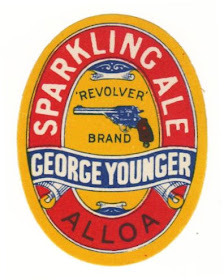The method we've got to now - force carbonation, basically - is the method that was most widespread in the 20th century. Though with some modification, principally in the form of pasteurisation. But let's not get ahead of ourselves.
"Bottling Process No. III.—Artificial Gas Bottling.
This process has only been introduced into this country a few years, but it is now very largely practised, especially in breweries, and it has, I am glad to say, to a very great extent replaced the forced bottling which was rapidly bringing bottled ale into disrepute. Any well-brewed ale, not carrying too much readily fermentable matter at rack, may be bottled by this process, and since the introduction of efficient filters the question of time is almost eliminated; thus I have seen beer straight from the rack, pumped through the filter, bottled off under a fair head of gas, and the bottle drawn for use at once. This, however, is not to be recommended, as such beers invariably taste flavourless and are wanting in character."
Journal of the Federated Institutes of Brewing, Volume 7, Issue 2, March-April 1901, page 196.
This was a very much shorter process than the other methods. Essentially, the beer was bottled immediately at the end of primary fermentation, i.e. racking time. Note that it was only filtered, not pasteurised. Knowing that they didn't sterile filter at the time, that means there was live yeast present in the bottle. Which explains the next passage:
"Storage wonderfully improves artificially gassed ales, and if the beer has been allowed to mature prior to bottling, and a sufficient gas pressure has been used at bottling, very nice beers may be produced, although they never really attain the flavour and character of true bottled ales unless they are kept a sufficient time to enable natural bottle fermentation to set in, and produce the extra gas pressure and modify the composition of the beer in the bottle, in which case they practically become true bottled ales as described under Process I. A very large amount of lager beer is bottled in this way; but it is specially brewed for the purpose, and no doubt if, as seems probable, the convenience of the method leads to its being more generally adopted in this country, the brewer will more especially modify his process of manufacture and produce a beer which will give the public satisfaction when bottled with carbonic acid gas produced by a separate process."
Journal of the Federated Institutes of Brewing, Volume 7, Issue 2, March-April 1901, pages 196 - 197.
If I read that correctly, if left, beer bottled this way would eventually start to bottle condition and become soemthing akin to a "true bottled ale". So presumably this must have created a sediment in the beer. Very strange. I imagine most beer never got to that stage, having been consumed soon after bottling. Clarity of the beer and the speed of getting it into the trade must have been the main reasons for using this method.
The method was later modified to include pasteurisation which ensured that the beer would remain bright and free of sediment. All the yeast having been killed, there was no way a bottle fermentation could kick in. Based on period advertisemnts and the names given to such bottled beers Sparkling Ale, All-Bright Ale, Crystal Ale - lack of sediment was a popular attribute with the public.
"In America, one of the special requirements in bottled ale, in fact in all ale, is that it shall carry a very dense, creamy head, and this is secured, to a great extent, by bottling in the cold under excessive pressure.
I have seen a sample of Burton strong ale so bottled in New York and returned to this country, and I cannot but admit that when drawn it was superior to any ale of similar quality that I had previously tasted.
At present, however, the English consumer appears to be satisfied with the moderate amount of gas which ordinary bottling produces, and so long as that gas is thoroughly taken into solution in the ale and not simply held in suspension, it leaves very little to be desired."
Journal of the Federated Institutes of Brewing, Volume 7, Issue 2, March-April 1901, page 197.
I've just unearthed more articles that describe in greater detail the North American system of brewing and bottling. They confirm the American public's demand for a thick head on Ale. And not just bottled Ale, draught Ale, too. You should see the method used to ensure a high concentration of CO2 in cask beer. Sounds pretty scary to me.
We'll be looking at that sometime in the near future, when I've finished squeezing out the final drops of interest from this article. In other words: still lots more bottling fun to come.









